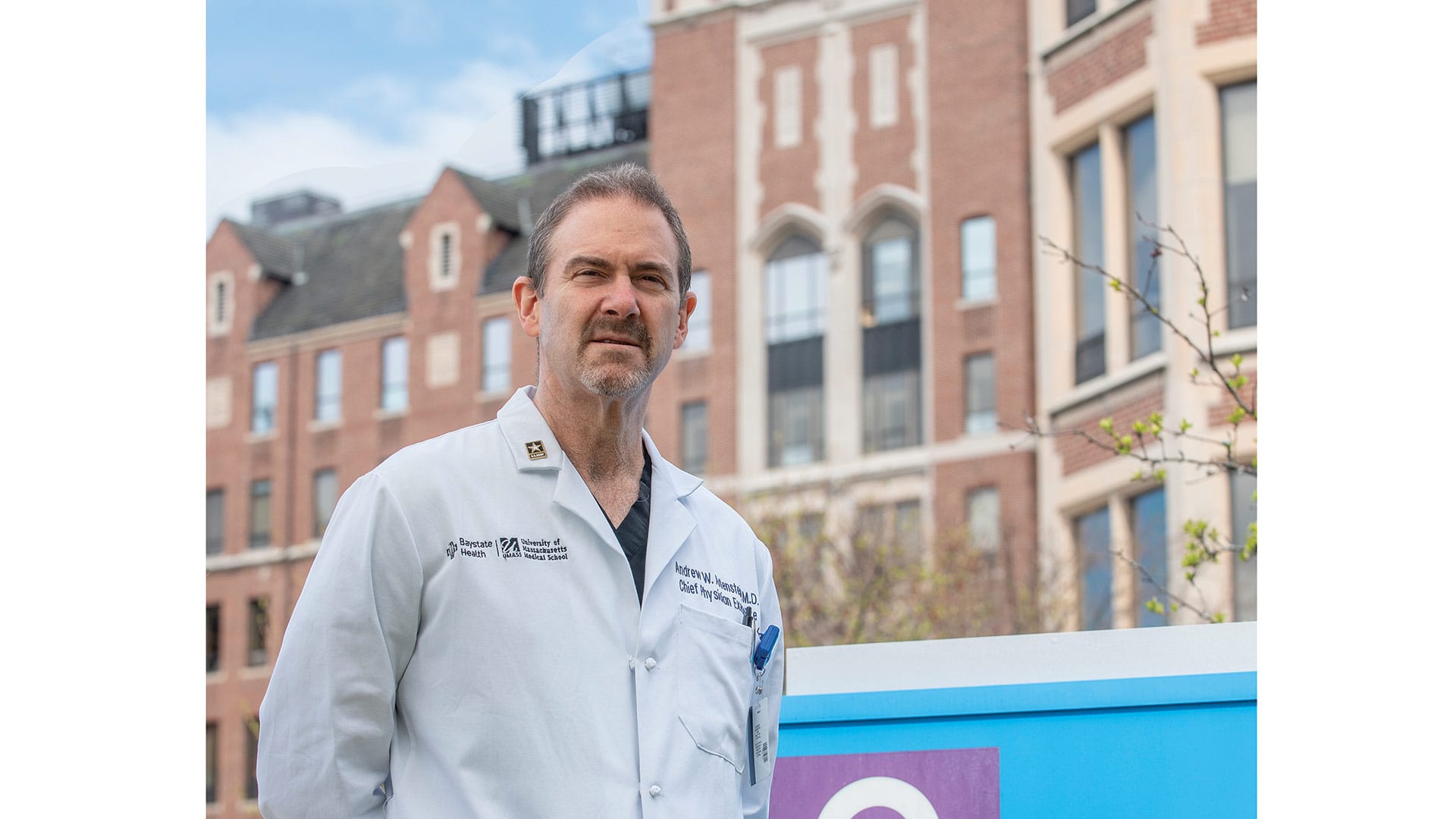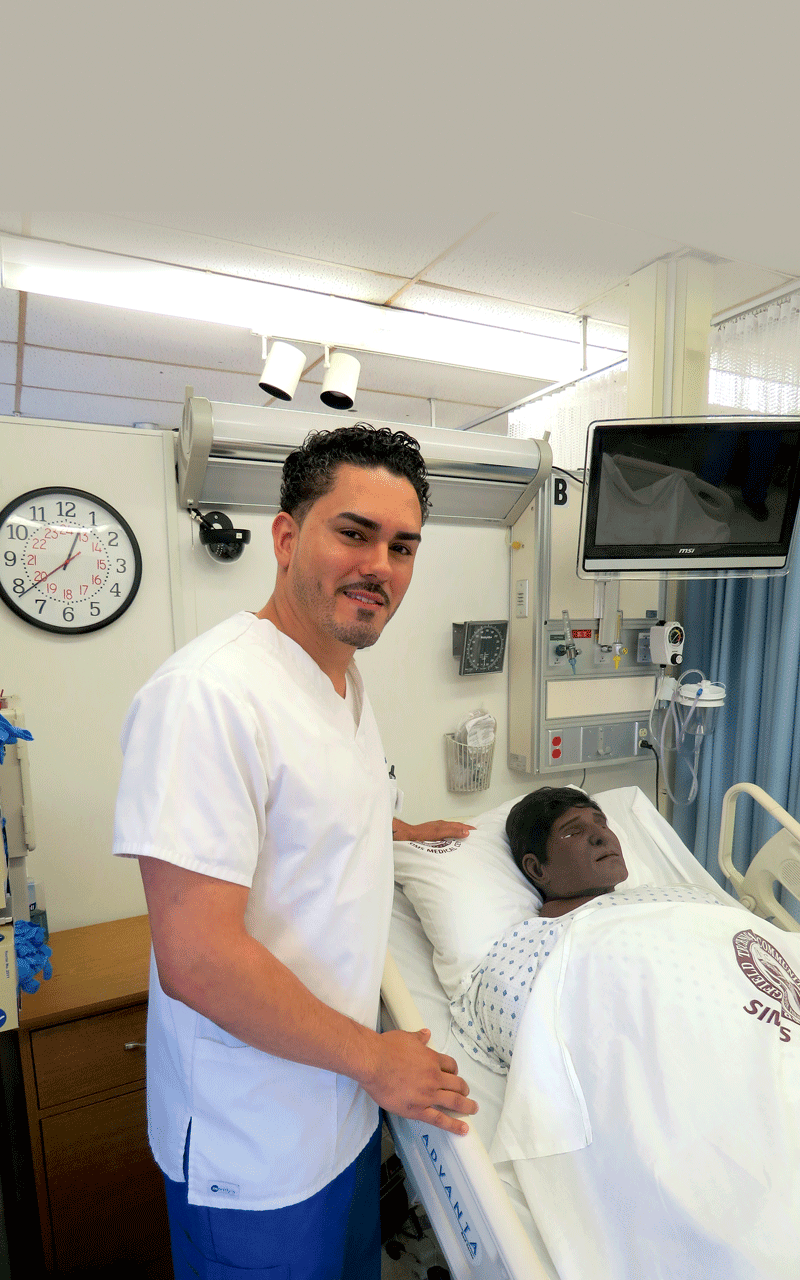Hospitals Gird for a Potential COVID-19 Surge
Life on the Front Lines
Dr. Andrew Artenstein isn’t the first to notice the lack of cars on the roads, but he’s certainly among those most invested in those open roads.
“When I leave work, I’m used to traffic, and there’s no traffic,” said the chief physician executive and chief academic officer at Baystate Health. “Every day feels like Sunday out there. The streets are a lot quieter. Hospitals don’t have visitors, so the hallways are quieter.”
Fewer people out and about means the social-distancing movement has largely taken hold in Western Mass., meaning fewer transmissions of the novel coronavirus and fewer cases of COVID-19 than would be present if people weren’t staying home. The question is, how much difference will it make in the end?
“I can tell you that I don’t know the effect, but I do know anything will help,” Artenstein told HCN. “It’s the right thing to do, and it will hopefully blunt the peak. It will not prevent it totally, but if you can blunt the peak, flatten the curve, we can possibly manage the surge.”
What that surge will represent wasn’t clear at press time, when the state had tallied close to 10,000 cases of COVID-19 — a number that is likely much higher as you’re reading this.

Based on expert estimates, Gov. Charlie Baker said Thursday that coronavirus hospitalizations in the state will likely peak between April 10 and April 20, with the total estimate of coronavirus cases in the state ranging from 47,000 to 172,000 over the course of the epidemic, or about 0.7% to 2.5% of the population.
“It appears the community has done a really good job of generally heeding the recommendations from our national and state public-health experts, which is, if you’re not sick, don’t come to the hospital,” Artenstein went on. “People still need other types of care; people still have cardiac issues or lung issues or kidney issues. That’s not going to stop. But people who don’t need emergency or hospital-level care, for the most part, are finding care in other ways, which is what they’re being told to do. That keeps people from transmitting infection in hospitals, and keeps them away from other patients who might be sick.”
That means patient volume for non-urgent matters is indeed down at Baystate, with some of that work being moved to telephone or telehealth platforms (more on that later), as well as outpatient clinics and urgent-care centers, all of which are also trying to enforce social distancing as best they can.
“It appears the community has done a really good job of generally heeding the recommendations from our national and state public-health experts, which is, if you’re not sick, don’t come to the hospital.”
What is on the rise in the emergency room are cases of respiratory illness, fevers, and coughs, with many of those being admitted and testing positive for coronavirus.
“There’s clearly a lot of transmission going on in the community, which is exactly what you’d expect from a pandemic,” he said. “If you look at the data, the vast majority of people [with the virus] are not sick enough to need to go to the hospital, but they’re still infectious and potentially transmitting it if they’re not isolating themselves.”
Artenstein should know all about the effects of isolation on pandemics. He founded and directed the Center for Biodefense and Emerging Pathogens at Brown University for more than a decade before arriving at Baystate, so “I have a fair amount of experience with these things. But this is a unique experience … a 100-year event.”
It’s an event that has seen Mercy Medical Center, like Baystate, shift from a strategy prioritizing preventive wellness to one that focuses on readiness and the immediate response to coronavirus — and an expansion of capacity where possible, said Dr. Robert Roose, the hospital’s chief medical officer.
“At this point, we have been heavily focused on increasing our available beds and staffing to continue to respond to the needs of the community, and we have been seeing increasing numbers of patients infected with COVID — and the acuity of those cases continues to increase,” he told HCN.
That increase in the number of patients requiring hospitalization reflects what Mercy’s leaders are tracking on a national level, and he expects the trend to increase over the coming weeks.
“In regard to our local preparedness, we have a robust surge plan that identifies three different levels of escalation to increase our capacity to treat increasing numbers of patients,” he explained. “We’re also coordinating with other local and regional hospitals on a surge-capacity plan in the event we need to share resources among different hospitals in the region.”
Testing, Testing
What would help predict and manage the coming surge is a more robust array of testing resources, but local hospitals are still hampered by a limit on how much is available at the state level.
“At the present moment, we’re prioritizing testing patients who are symptomatic and in need of care in the Emergency Department, as well as healthcare workers and first responders,” Roose said. “We’re prioritizing those groups per the CDC, and as testing capacity increases, then we’ll be able to offer more testing as it becomes more readily available.”
“At this point, we have been heavily focused on increasing our available beds and staffing to continue to respond to the needs of the community, and we have been seeing increasing numbers of patients infected with COVID — and the acuity of those cases continues to increase.”
Artenstein reported the same protocol for priority test groups: patients hospitalized with symptoms, employees showing symptoms, and some first responders who are symptomatic. “We know it’s not in our control; it’s a national issue, and we’ve been severely limited in our ability to test. It’s starting to improve because of a tremendous effort by people at Baystate and some of our government officials to help us get more testing and more capacity and more rapid turnaround time. We’re starting to see an improvement, but it’s still not where it needs to be.”
As for the coming surge, Baystate began preparing for that in a number of ways over the past few weeks, including the construction of a rapid-response triage facility just outside the entrance to the ER. It holds around 40 chairs — each of them six feet apart — for individuals entering the ER.
“There’s community transmission of the virus at this point,” said Dr. Niels Rathlev, chair of the Department of Emergency Medicine, when the project was announced last month. “And we really are preparing for more patients showing up for screening. This is not to expand testing; the real issue is to try to keep patients that don’t require admission to the hospital — acute emergency care — and screen them rapidly out here.”

Construction of the triage center is a step that mirrors what is happening in other parts of the country, Rathlev noted, adding that some areas, such as the state of Washington, established such centers weeks ago in anticipation of a surge in visits to the ER and the critical need to triage those coming in. Meanwhile, field hospitals are being created at sites like Worcester’s DCU Center and the Boston Convention and Exposition Center.
Capacity concerns also cross over into the realm of protective equipment like masks and gloves. Roose said Mercy is working aggressively with suppliers to make sure it has what it needs. “I will say we have supplies, but I don’t think any hospital around here feels particularly comfortable with the amount they have because there may be a large influx of patients at any time.”
It’s a problem that has required some creativity. Last Thursday, Patriots owner Robert Kraft sent a team plane to China to pick up 1.2 million N95 masks. In all, Kraft partnered with the state to purchase 1.4 million masks for Massachusetts, and purchased another 300,000 protective masks for New York.
Locally, institutions have stepped up enthusiastically to meet the need. Springfield Technical Community College’s (STCC) School of Health and Patient Simulation donated personal protective equipment — including surgical masks, isolation gowns, and exam gloves — to Baystate Medical Center, Mercy Medical Center, Holyoke Medical Center, and Cooley Dickinson Hospital, in addition to emergency medical services personnel in the West Springfield Fire Department.
“We recognize there is a critical need for personal protective equipment at hospitals and medical centers,” said Christopher Scott, dean of the School of Health and Patient Simulation at STCC. “By donating our supplies, we are doing what we can to protect the healthcare workers who are running short on masks and other protective equipment. The community needs to work together to ensure we defeat this pandemic.”
Holyoke Community College donated similar equipment from its health-science programs to area hospitals. HCC Police Captain Dale Brown spent a day last month conducting an inventory of collected supplies — including boxes of isolation gowns, exam gloves, masks, goggles, hand sanitizer, and microbial wipes — at the Campus Police station. A representative from the Massachusetts Emergency Management Agency picked everything up to coordinate delivery to area hospitals.
“I will say we have supplies, but I don’t think any hospital around here feels particularly comfortable with the amount they have because there may be a large influx of patients at any time.”
Even Dakin Humane Society pitched in, donating its in-house supply of disposable surgical gowns and booties, along with other personal protective equipment, to Baystate.
“We’ve seen news stories about the need for protective equipment being faced by those in human healthcare, so we reached out to Baystate Medical Center because they’re local,” said Karina King, Dakin’s director of Operations. “We anticipated that human health workers would need these supplies soon, so we recently stopped using disposable items at Dakin and found alternative equipment, including smocks that could be laundered and re-used instead of being disposed of.”
A researcher from UMass Amherst contributed in a different way, with a dose of data. Richard Peltier, a professor in the university’s School of Public Health and Health Sciences, partnered with Dr. Brian Hollenbeck, chief of Infectious Disease at New England Baptist Hospital in Boston, to test in his lab whether used N95 facemasks were still effective at blocking infectious particles after sterilization. They determined that, yes, masks could be safely sterilized and reused.
“While these are ordinarily disposable protective devices for medical workers, these are not ordinary times,” Peltier said, “and this science shows that sterilized face masks will protect our healthcare providers who are working under extraordinary conditions.”
Across the Distance
In short, there’s a lot going on to both help hospitals prepare for the surge and to reduce non-critical traffic as much as possible. To that end, a number of institutions have stepped up their telehealth efforts, including Valley Health Systems, which includes Holyoke Medical Center, Holyoke Medical Group, and River Valley Counseling Center.
“We are expanding our capabilities to meet the needs of our patients, especially those with ongoing health concerns that need to be treated and in contact with their healthcare providers,” said Spiros Hatiras, president and CEO of HMC. “It is important for everyone to maintain their health and safety regarding pre-existing conditions, as much as it is to protect from COVID-19.”
Behavioral Health Network (BHN) introduced a new program, BHNTeleCare, that allows individuals to continue counseling sessions with their therapists from the safety of their own homes.
According to Katherine Wilson, president and CEO of BHN, “this innovation in the way we provide therapy and counseling services is groundbreaking and allows us to render services where people are. This is particularly critical as a result of the needs that have emerged due to the spread of COVID-19. It allows a counseling avenue for those suffering anxiety and in need of support during this time of crisis affecting individuals and families.”
Meanwhile, MHA also introduced its new TeleWell virtual service delivery, which allows mental-health clinicians and their clients make virtual connections using a smartphone, tablet, or computer.
“With social distancing now part of daily life, people who receive therapy for emotional support, or who would like to, may experience uncertainty when it comes to making and keeping office-based appointments,” said Sara Kendall, vice president of Clinical Operations for MHA. “TeleWell provides another option by enabling people to keep their appointments virtually. Every day, more BestLife clients are using this option.”
All these efforts — including simply staying at home to avoid transmission — are helping, Roose said.
“I cannot stress enough how important the efforts of the community are in ensuring that our healthcare providers and resources adequately meet the needs of this crisis,” he said. “Physical distancing, diligent hand washing, isolating and quarantines when appropriate — those are the efforts that will flatten the curve and lessen the impact of this disease, and ensure that our healthcare providers have what they need to provide the care the community needs.
Meanwhile, Mercy’s incident command center continues to keep in contact with the entire Trinity Health system every day. “And every single day, I stress the importance of efforts we can all take to impact this disease. It’s something we all have the power to impact if we take proper precautions and follow the guidelines around physical distancing and quarantines. I can’t stress that enough.”
Those community efforts don’t guarantee Massachusetts won’t become as strained as New York City, Artenstein said, but they help.
“My feeling is that April is going to be very challenging in Western Massachusetts, and after that, I don’t know,” he told HCN. “It quite possibly could extend well into May. I don’t think we’ll be completely out of the woods, and I do think, if you look at epidemics and pandemics, there are second and third waves sometimes.”
For example, he explained, the Spanish flu of 1918 saw a second wave late that year, and an even worse third wave arrived the following spring. COVID-19 has the potential of following a similar track because it’s new, and people haven’t built up the blanket of underlying immunity that keeps seasonal flu, while dangerous as well, under control.
“With each passing day, it becomes clearer we’re living in an unprecedented time, and with that comes uncertainty,” Roose added. “As this pandemic evolves, we are all called upon to learn quickly, work collaboratively, and constantly change how we do things. This is a community crisis, and it takes involvement and the efforts and support of everyone in our community.”
Ready for the Surge
Roose emphasized that he greatly appreciates those efforts, not just in the community, but from the selfless healthcare workers on the front lines.
“I could not be more inspired and impressed by our teams of providers, clinicians, nurses, everyone showing a commitment to putting patients first and responding to the needs of the community,” he said. “In a crisis like this, people show their true character, and it’s clear to me we’re much stronger together, and our teams are rising to this challenge.”
Artenstein agreed.
“I’ve never seen a group of more dedicated, committed, and compassionate people than I’ve seen here,” he said. “They’re working hard in adverse conditions.”
At the same time, he added, “they’re nervous, scared for their familes, and scared for themselves — and they have the right to be scared. But our people are true to their mission to provide excellent, compassionate care.”
No matter what form the April surge may take.
“This is a very unique point in our history — one that, hopefully, we’ll look back on and not have to relive.”



